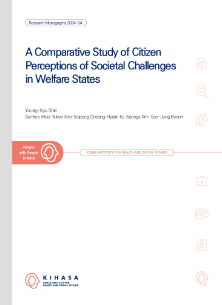
KIHASA 발간물연구보고서 ; Research Monographs 2024-04 2024-04
A Comparative Study of Citizen Perceptions of Societal Challenges in Welfare States
- 서명/저자사항
- A Comparative Study of Citizen Perceptions of Societal Challenges in Welfare States / Young-Kyu Shin , Sunhee Woo , Yuhwi Kim , Sejeong Cheong , Hyejin Ko , Seonga Kim , Soo-Jung Byoun
- 개인저자
- Shin, Young-Kyu | Woo, Sunhee | Kim, Yuhwi | Cheong, Sejeong | Ko, Hyejin | Kim, Seonga | Byoun, Soo-Jung
- 발행사항
- 세종 : 한국보건사회연구원 , 2024
- 형태사항
- 148p. : 도표 ; 26cm
- 총서사항
- 연구보고서 2024-04 Research Monographs 2024-04
- ISBN
- 9791172520199
- 주기사항
- 참고문헌 수록
- URL
소장정보
| 위치 | 등록번호 | 청구기호 / 출력 | 상태 | 반납예정일 |
|---|---|---|---|---|
이용 가능 (2) | ||||
| 자료실 | EM054621 | 대출가능 | - | |
| 자료실 | EM054622 | 대출가능 | - | |
이용 가능 (2)
- 등록번호
- EM054621
- 상태/반납예정일
- 대출가능
- -
- 위치/청구기호(출력)
- 자료실
- 등록번호
- EM054622
- 상태/반납예정일
- 대출가능
- -
- 위치/청구기호(출력)
- 자료실
책 소개
South Korea, like many advanced capitalist countries, faces challenges such as demographic changes, immigration, automation, and climate change. The 10-country survey of this study highlights several key findings about South Korean attitudes. First, despite South Korea’s economic success, there is a high level of concern about globalization, which may stem from uncertainties about the future. Second, South Koreans show insensitivity toward immigrants and ethnic diversity, which could lead to social conflicts. Third, despite having strong digital skills, South Koreans are less confident in their abilities and fear job obsolescence due to new technologies. Lastly, South Koreans express significant concern about climate change, though many worry that climate policies could negatively impact political and economic equality.
목차
Abstract 1
Contents
1. Introduction 5
1.1 Background 7
1.2 Objectives and Main Themes 8
2. Methodology 21
2.1 Survey Design and Data collection 23
2.2 Composition of Survey Questionnaire 25
3. Findings 33
3.1 Socio-demographic Characteristics and Attitudes 35
3.2 Diversity in Organizations 48
3.3 Social Risks and Trust 56
3.4 Digitalization and Automation 77
3.5 Climate Change 100
4. Conclusions 111
4.1 Summary of Key Findings 113
4.2 Implications 117
References 119
Appendices 121
요 약 147
